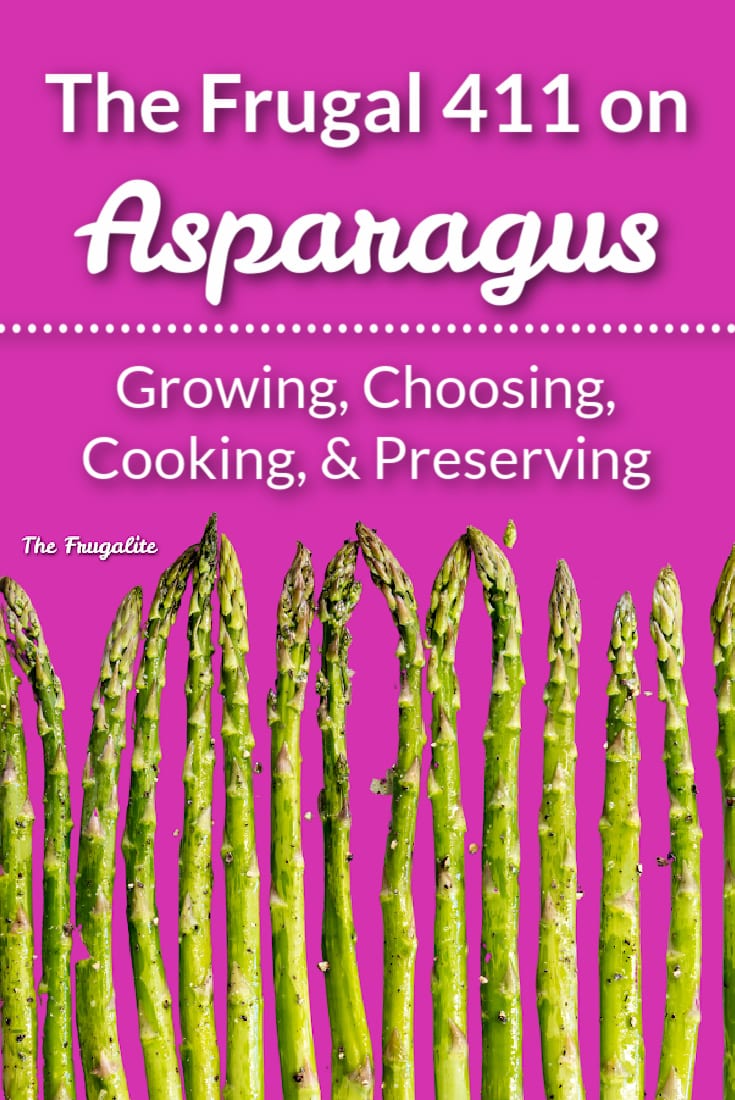(Psst: The FTC wants me to remind you that this website contains affiliate links. That means if you make a purchase from a link you click on, I might receive a small commission. This does not increase the price you’ll pay for that item nor does it decrease the awesomeness of the item. ~ Daisy)
Tender delicious stalks of asparagus are appearing in gardens and farmer’s markets across North America right now. Grabbing good stuff when it’s in season is thrifty. Preserving it for later is at the top of the Frugalite Pyramid of awesomeness.
First, some asparagus trivia.
Asparagus is a member of the lily family. Historical records indicate the consumption of asparagus in Egypt in 3000
Ancient Greeks and Romans consumed it fresh and dried it to preserve it for out-of-season eating.
When you mention asparagus, many people immediately think of a distinct odor in the urine. Some people don’t notice the smell, and interestingly, the difference is genetically based. Two areas contribute to this – some people do not produce the odor and some people produce the odor but cannot smell it:
Most people detect a distinct sulfurous odor in their urine shortly after eating asparagus. However, there are some who seemingly do not notice the unpleasant odor.
Up until now, it has been unclear whether this is because these individuals do not produce the odor or because they cannot smell it.
Addressing this mystery from several angles, scientists from the Monell Center first used sophisticated sensory testing techniques to show that both explanations apply: approximately eight percent of the subjects tested did not produce the odorous substance, while six percent were unable to smell the odor. One person both did not produce the odor and was unable to smell it.
Next, DNA samples collected from each subject revealed that the inability to smell asparagus odor was linked to genetic variation within a family of olfactory receptors.
“This is one of only a few examples to date showing genetic differences among humans in their sense of smell,” said study co-author Danielle Reed, Ph.D., a Monell behavioral geneticist. “Specifically, we have learned that changes in an olfactory receptor gene can have a large effect on a person’s ability to smell certain sulfurous compounds.
Other such compounds include mercaptan, the chemical used
to add odor to natural gas so that people are able to detect it.” (source)
Health Benefits of Asparagus
The pale green spears are absolutely packed with nutritional benefits.
- Fresh asparagus is an excellent source of the B-complex vitamins, as well as folate, and vitamins C, E, A, and K.
- Asparagus contains beneficial amounts of minerals like copper, iron, calcium, potassium, manganese, and phosphorus.
- A one cup serving of asparagus has 32 calories, 3 grams of dietary fiber, and 5 grams of protein.
- Asparagus has many anti-inflammatory compounds, such as asparagus saponins, including asparanin A, sarsasapogenin, protodioscin, and diosgenin. This makes asparagus very beneficial for anyone who suffers from inflammatory diseases such as arthritis and certain autoimmune disorders.
- Asparagus is loaded with antioxidants: vitamin C, betacarotene, vitamin E, and the minerals zinc, manganese, and selenium. Anti-oxidants improve the immune system and help to protect against cell-damaging free radicals.
- Asparagus helps to support heart health, blood sugar regulation and can aid in protecting your body from cancer.
Asparagus has also been used holistically since ancient times. Asparagus is a diuretic and can be used to help with kidney or bladder issues. Asparagus has cleansing properties which make it an excellent addition to a detox
program. Ayurvedic practitioners recommend asparagus as an aid to female reproductive issues, from PMS to infertility.
Growing Asparagus
Asparagus is very easy to add to your own garden, because it is perennial. Plant the crowns about one foot deep in sandy soil. The Michigan Asparagus Advisory Board shares these interesting facts about growing asparagus.
- Under ideal conditions, an asparagus spear can grow 10″ in a 24-hour period.
- Each crown will send spears up for about 6-7 weeks during the spring and early summer.
- The outdoor temperature determines how much time will be between each picking…early in the season, there may be 45 days between pickings and as the days and nights get warmer, a particular field may have to be picked every 24 hours.
- After harvesting is done the spears grow into ferns, which produce red berries and the food and nutrients necessary for a healthy and productive crop the next season.
Selecting, Washing, and Storing Asparagus
Everyone has a decisive opinion on which asparagus is the best – the thick spears of the thin spears. (My personal preference is the thin, delicate spears.) Whichever you opt for, the tips should be tightly closed. Heritage varieties of asparagus can be purple, white, or the most common, pale green.
Asparagus is very rarely sprayed with pesticide, which means it isn’t necessary to spend the extra money on organic varieties.
Wash asparagus gently and then store it in the refrigerator with a damp paper towel around the cut ends.
Preparing Fresh Asparagus
Spring vegetables are so loaded with flavor that all you really need to do is lightly steam them, and asparagus is no exception. If you have thick spears of asparagus, use a carrot peeler to peel away the tough outer layer of the bottom part of the stem and cut off the woody end, before steaming. Steam asparagus for approximately 5 minutes for tender-crisp spears that you can pick up and eat with your fingers.
Try seasoning asparagus with butter, lemon juice, and freshly grated Parmesan cheese.
Asparagus also responds well to being lightly stir-fried, grilled, or roasted in olive oil.
Preserving Asparagus
I’m not going to lie – asparagus is one of those vegetables that really doesn’t preserve well. Some people don’t mind it, but to me, the mushy texture that you end up with at serving time is very unappetizing.
This being said, home-canned asparagus is a very nice base for a wintertime treat of cream of asparagus soup. (See the recipe below.) Use preserved asparagus in soups, stews, casseroles and pasta dishes.
Dehydration
- After washing your asparagus, cut it into 1-inch pieces. Very thick pieces should be sliced down the center.
- Blanch the pieces in boiling water for 30 seconds.
- After allowing the asparagus to cool, pat it dry thoroughly and place it in a single layer on the dehydrator racks.
- Dry in the dehydrator for about 6 hours.
Store your dried asparagus in tightly closed glass canning jars.
Freezing
- To freeze a fresh asparagus harvest, wash it carefully.
- Next, blanch the whole spears in boiling water for two minutes.
- Immediately place the blanched asparagus into an ice bath.
- Remove the spears from the ice bath and pat them dry.
- Place them on a cookie sheet in a single layer and place this in the freezer for two hours.
Store the frozen asparagus in large freezer bags.
Canning
Asparagus is a low-acid vegetable, so it MUST be pressure canned. The one exception to this rule is pickled asparagus, because the acidity of the vinegar makes it safe to water bath can. (See the recipe below.) The canning instructions are from my book, The Prepper’s Caning Guide.
Ingredients:
- Fresh asparagus
- Salt
- Boiling water
Directions:
- Prep your asparagus spears by washing them and removing the woody ends.
- If necessary, cut the spears into the proper length to put into your jars.
- Place the spears head up into your sanitized jars.
- Top each jar with a sprinkle of salt and cover the spears with boiling water. Wipe the rim and cap your jars with snap lids and rings.
- Process in a pressure canner for 30 minutes, adjusting for altitude.
Canning Pickled Asparagus
Ingredients
- 5 pounds of fresh asparagus
- 4 cups of white vinegar
- 4cups of water
- 1 cup of sugar
- 6 tbps of pickling salt
Divide these spices evenly into 6 sanitized pint jars:
- 6 cloves of garlic
- 1 teaspoon of crushed chili pepper flakes
- 6 sprigs of fresh dill 3 tbsp of dill seeds
- 3 tsp of mustard seeds Directions:
- Wash your asparagus, then remove the woody ends.
- Cut the asparagus to lengths that will stand up nicely in your pint jars.
- Meanwhile, in a large pot, bring water, vinegar, salt and sugar to a boil.
- Divide the spices evenly across the jars.
- Fill the jars with asparagus spears.
- Pour the boiling liquid over the asparagus until it is completely covered.
- Wipe the rim and cap your jars with snap lids and rings.
- Process in a water bath canner for 10 minutes, adjusting for altitude.
It’s hard, but to get the peak flavor, wait at least 2 weeks before popping open the first jar of pickled asparagus.
Cream of Asparagus Soup with Bacon
Here’s a family-favorite way to use up our canned asparagus.
Ingredients:
- 3 slices of bacon
- 2 tbsp flour
- 2 cloves of garlic, finely minced
- 1/4 cup of onion, finely minced
- Up to 1 cup of liquid from canned asparagus
- 1 cup of milk or cream
- 2 pint jars of home canned asparagus
- salt and pepper, and fresh Parmesan cheese to taste
Variation: Instead of bacon, substitute 2-3 tbsp of butter for the bacon drippings.
Directions:
- Cook 3 slices of bacon over medium heat in a large saucepan until crispy, then put the bacon on a paper towel lined plate and reserve for garnish.
- Pour the bacon drippings out of the pan and then put 2 tablespoons back in. (If you use too much of the drippings your soup will be greasy.)
- Add garlic and onion to the bacon drippings and sauté until lightly golden and fragrant.
- Dip out the garlic and onion with a slotted spoon, draining it against the side of the saucepan, and place it into the blender or food processor.
- Add the flour to the bacon drippings, whisking to mix it well. (You might need to add a tiny bit more bacon drippings here, but don’t go overboard.)Then, add milk and jar liquid, whisking constantly.
- When the contents of the stockpot begin to thicken, add your asparagus to the garlic and onion in the food processor or blender. (If you don’t have a food processor or blender, you can use a potato masher to mash it.) The texture is according to personal tastes – you can leave it a little chunkier or make it totally smooth.
- Pour the asparagus into the mixture in the saucepan and stir well to combine.
- Bring it to a simmer, stirring frequently until it is heated through.
Season the soup to taste with salt and pepper. Garnish lavishly with Parmesan and crumbled bacon. Serve with crusty bread.
What do you do with asparagus?
What are your favorite ways to cook and enjoy asparagus? How do you preserve it? Share your asparagus wisdom in the comments!












10 thoughts on “The Frugal 411 on Asparagus (In-Season)”
I don’t have much of it so I like to eat it raw and plain soon as I pick it.
Your soup sounds very good so I’ll have to try it. Thanks
We love asparagus! Soup and roasted are two favorites.
Marinaded in balsamic vinegar salt garlic and olive oil cooked on bbq
I poach asparagus 2 or 3 spears at a time in rapidly boiling water for 1 minute. Then serve it drizzled with soy sauce and toasted sesame oil. I like asparagus soup but I find eating it fresh from the garden like this so satisfying I never do anything else with it.
I have to agree with you about preserved asparagus; not worth the effort. We gorge ourselves while it’s in season and then forget about it until next year
I love fresh asparagus lightly steamed or boiled just till tender with a bit of salt. Hot or cold in a salad I enjoy every bite. Your soup would be great but I don’t usually have that much at a time. I’m starting asparagus from seed to add to a negIected little patch here. If all 40 make it I’ll be happy. Right now they are looking good. When they are a bit more mature I’ll plant them. It’s a bit early here.
My mom loved a cream of asparagus soup. My late husband liked It hot pickled. Current husband hates anything green. I love asparagus any way I can get it. I try to buy one bunch or two each spring. This year I bought seed instead so I can add to the old planting that had nearly all died out from neglect.
I steam fresh asparagus until fork tender (barely piercing the stems), and serve with vinagrette (1 part brown mustard, 3 parts red/white vinegar, 9 parts olive oil).
I’m considering trying to freeze dry some asparagus this year. So far, I’ve got way more than past years and I don’t know if my wife and I can eat this much before spoilage occurs. Anyone have any experience with freeze drying/reconstituting?
Ray
My favorite story about asparagus is political. A few years ago my town council adopted a highly abusive property maintenance code that allowed code enforcement to threaten fines of up to $2,100 per day per cited offense for things as trivial as illegal “weeds” in a lawn over 12 inches high. When I got their notice of my alleged offense I did a little digging and learned that my six foot high asparagus plants in my front yard were legally considered as garden plants that were specifically excluded by the city ordinance from code enforcement’s jurisdiction. When I emailed them that unless they backed off on their threat to break me financially, I would file a criminal complaint with the county attorney on grounds of their felonious (given the high dollar amount potential) extortion threats, they suddenly “went dark” and I never heard from them again. My six foot asparagus plants in my front yard have continued to thrive year after year ever since that nasty abusive and ignorant attack was shut down.
–Lewis
Had numerous beds at my previous home – transplanted small plants at the new home where a small bed was started.
I freeze it raw – it isn’t eaten as a side dish but added to other dishes it works fine. For a number of years we still harvested at our previous home as it was a rental property – renters didn’t eat asparagus.
One of our favorite dishes is morels, asparagus, and bacon.
Morels, asparagus, and bacon are delicious and I think especially so because it’s only available for such a brief time.